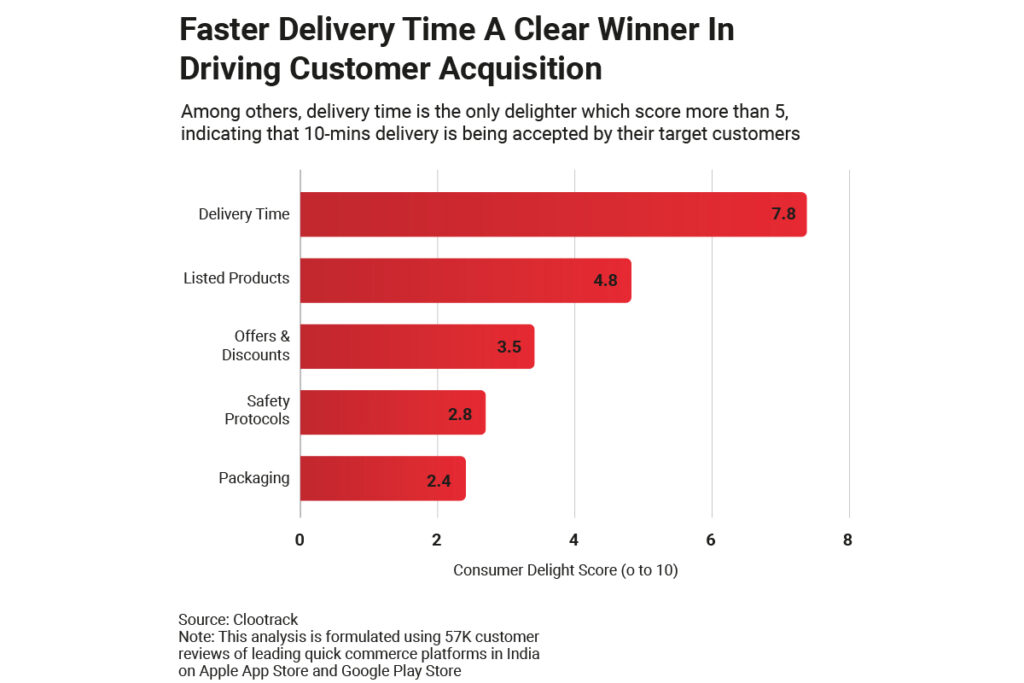With a slowdown seen among quick commerce players, why is it proving hard to deliver on this promise?
Words by Sakshi Dhingra
In recent years, with the rising use of technology, there has been an increase in the use of online delivery services, and an inevitable heating up of the quick commerce sector, be it for getting your food, grocery supplies, or a gizmo delivered to you in lightning quick time. The sight of a rider zipping through city traffic clad in the colours of one of the companies dotting this space has become a familiar urban sight.
Zomato is one of these players, pushing the boundaries of possibilities as they rewrote the norms. In March 2022, they announced the introduction of 10-minute food delivery, with CEO Deepinder Goyal saying, “Nobody in the world has so far delivered hot and fresh food in under 10 minutes at scale, and we were eager to be the first to create this category, globally!”
Less than a year on, that service was shuttered as market conditions dictated favouring profitability over speed, although Zomato says it has not shut down the service, but simply rebranded it. “Instant is not shutting down. We are working on a new menu with our partners and rebranding the business. All finishing stations remain intact, and no people are impacted by this decision.”
Zomato weren’t the only ones to test the waters either. Ola ventured into 10-minute food delivery in a few locations in Bengaluru last year, with food-technology startup Voosh following suit, and Zepto launched Zepto Cafe in Mumbai around the same time. Domino’s, for long the innovator when it came to quick deliveries, buckled down and slashed delivery times from 30 to 20 minutes, and even Reliance took the leap of faith with JioMart Express, with 90 minute deliveries promised.
Swiggy, a key competitor for Zomato, was bullish on the sector, to the tune of setting aside $700 million raised externally for its quick commerce business, Instamart. In time, these players have come to realise that while delivery time is a major differentiator, there’s more than one way to rise to the top, such as a wide variety of listed products, private labels to boost profitability, and efficient delivery that doesn’t drop the ball. This is perhaps why Ola has rolled back Ola Dash, why Voosh has pivoted to becoming a SaaS (Software as a Service) player, and why Swiggy no longer advertises a delivery time on their apps.

So what drove this feeding frenzy?
A refocusing of priorities
It’s easy to see why the opportunity size excited onlookers and industry professionals alike. Over the period spanning 2019-22, India’s online grocery market grew at a CAGR of 66% CAGR, according to a study by consulting firm Redseer, and the total value of goods sold via e-commerce platforms rose from $1.7 billion in 2019 to $8 billion in 2022. This number is expected to touch $19 billion in 2025.
Enamoured by this growth story, funds flowed into these quick delivery companies. Profits were a secondary objective, as growth was pursued at almost all costs, with a view to building a large enough customer base to leverage later. But as 2022 saw the advent of a funding winter, the question started to be asked; where were the profits going to come from?

Simply, by selling more products. Delivery costs will not vary greatly for a ₹1000 order over a ₹100 order, whereas the profit margins will obviously be higher on the former. Efforts are on to ramp up Average Order Values, which stands at ₹522 for Blinkit, ₹400 for Swiggy Instamart and ₹460 for BigBasket according to The Economic Times. This is why if you look closely, you’ll see these companies offering greater discounts for orders of a higher value, of ₹1000 and more.
In any case, with a focus on the long haul, improving unit economics has been seen as a priority. This can be done in multiple ways, such as delivery companies clubbing orders together, or focusing on shorter trips to ensure more deliveries per hour. For some orders, as many as five or six deliveries could be grouped to improve the overall economics, which helps to offset the discount given.
This strategy seems to be paying off. Zomato’s quick commerce business Blinkit saw its revenue jump 20% quarter-on-quarter to ₹363 crore in the period ending March 31, 2023, while its Gross Merchandise Value (GMV) increased 17% to ₹2,040 crore. Over at Swiggy, CEO Sriharsha Majety announced that the food delivery business turned profitable in March for the first time since the company’s launch in 2014 and Prosus—one of Swiggy’s biggest investors—said last year that the GMV of Swiggy’s food delivery arm grew 40% in the January-July period this year.
Quick delivery, not a piece of cake
With the constant influx of professionals into cities and rising urbanisation in India, the food delivery and quick delivery industry still has some headroom for growth. It is safe to assume that online delivery apps are not a passing fad, and in order to stay up with the expanding demand and competition, they must continually analyse and re-examine their operations and procedures, as well as be alert to emerging possibilities. 10 minute deliveries might have gone the way of the dodo, but don’t expect India’s love affair with anytime delivery to fade away any time soon, even if it seems certain that lightning fast-delivery won’t strike twice.


